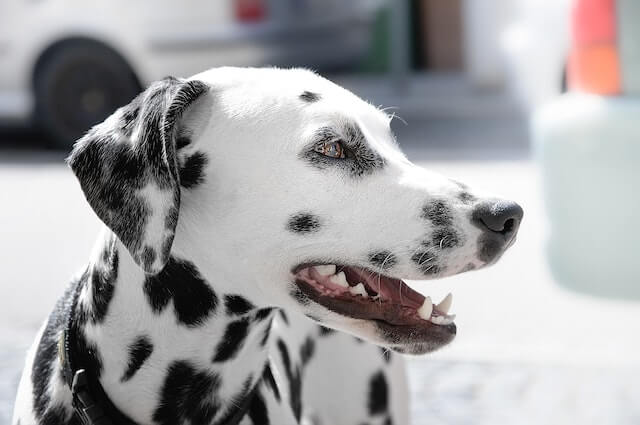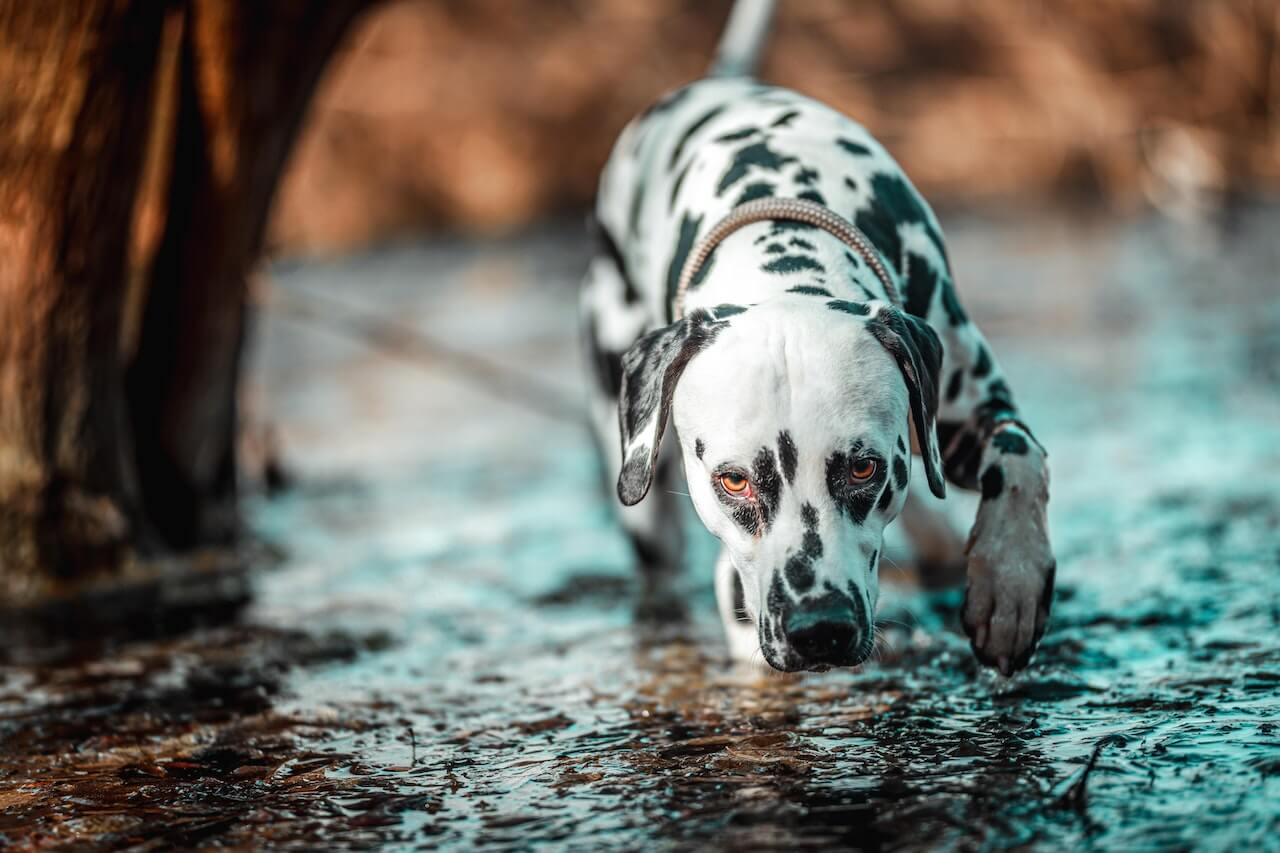Think about those dogs with cool black spots and a classy, dignified look – yes, we’re talking about Dalmatians! But have you ever wondered Why Are Dalmatians Not Popular? It’s a bit of a puzzle, but don’t worry, we’re here to unravel it for you.
In this blog post, we’re going to dig into why Dalmatians aren’t as famous as some of their canine buddies. We’ll take a closer look at their interesting personalities, their special care needs, and even the impact of movies and media. By the end, you’ll have a much clearer picture of what’s behind the Dalmatian’s not-so-high profile in the world of dogs. So, if you’ve ever wondered why Dalmatians don’t steal the spotlight, keep reading, and we’ll spill the beans!
Surge and Decline of Dalmatians Popularity: An Overview
The popularity of Dalmatians has experienced surges and declines over the years, influenced by various factors. Here is an overview of the trends in Dalmatian popularity:
Surge in Popularity:
Disney’s “101 Dalmatians” (1961 and 1996): The release of Disney’s animated movie “101 Dalmatians” in 1961 and its live-action adaptation in 1996 contributed significantly to a surge in Dalmatian popularity. The films featured adorable Dalmatian puppies and sparked interest in the breed.
Fashion Trends: Dalmatians gained popularity as fashion accessories in the 1990s, often seen in advertisements and on clothing, which further increased their visibility and desirability.
Decline in Popularity:
Impulse Buying: Many people who were drawn to Dalmatians by their appearance and movie fame did not adequately research the breed’s needs and characteristics. This led to a surge in impulse buying, resulting in a significant number of Dalmatians ending up in shelters due to behavioral issues.
Behavioral Problems: Dalmatians have a reputation for being stubborn and sometimes aggressive, especially if not properly socialized and trained. Owners who couldn’t manage their Dalmatians’ behavior added to the decline in popularity.
Health Issues: The breed’s susceptibility to health issues, particularly deafness and urinary stones, discouraged potential owners who were concerned about the cost and care associated with these conditions.
Lack of Understanding: Many people acquired Dalmatians without understanding their exercise and mental stimulation needs, leading to bored and destructive dogs.
Overbreeding: The surge in popularity led to overbreeding, resulting in health and temperament issues in some Dalmatians. This further tarnished the breed’s reputation.
Preference for Other Breeds: As the years passed, other breeds with more predictable and manageable temperaments gained popularity, pushing Dalmatians into the background.
Negative Stereotypes: The Dalmatian’s reputation as a difficult breed to train and maintain contributed to negative stereotypes, dissuading potential owners.
In recent years, there has been a shift toward responsible breeding and ownership practices, with increased emphasis on educating prospective Dalmatian owners about the breed’s unique needs. While they may not be as popular as they were during their peak in the 1990s, Dalmatians continue to find loving homes with owners who are committed to meeting their specific requirements and providing proper training and care.
Why Are Dalmatians Not Popular? 12 Reasons
Dalmatians, known for their distinctive black spots and sleek white coats, have a unique and eye-catching appearance. However, they are not as popular as some other dog breeds for several reasons:
1. Exercise Needs
Dalmatians are highly energetic dogs that require a significant amount of exercise to stay happy and healthy. Their origins as carriage dogs have provided them with boundless stamina. Sadly, many potential owners underestimate the time and commitment required to meet their exercise needs, leading to a mismatch in lifestyle expectations.
2. Temperament
While Dalmatians can be loyal and affectionate companions, they possess an independent and stubborn streak. This temperament trait can make training a challenge for even experienced dog owners. Their strong-willed nature calls for consistent and patient guidance throughout their lives.
3. Aggression
Dalmatians, like any breed, can exhibit aggression if not properly trained and socialized. Poor breeding practices and lack of responsible ownership have sometimes contributed to the breed’s reputation for aggression. However, it’s crucial to understand that aggression in Dalmatians is not inherent but rather a result of inadequate training and socialization.
4. Health Issues
Unfortunately, Dalmatians are prone to certain genetic health conditions. One of the most well-known is their susceptibility to bladder stones due to their unique urinary system. These health concerns can lead to ongoing medical expenses and potential complications, making the breed a more challenging choice for some dog enthusiasts.
5. Shedding
Dalmatians have a short and dense coat that sheds profusely throughout the year. This constant shedding can be a challenge for individuals with allergies or those who prefer to maintain a meticulously clean living space. Regular grooming is necessary to minimize loose hair and keep their coat healthy.
6. Not Good with Small Children
While Dalmatians can be wonderful family pets and get along well with older children, they may not be the best fit for households with young kids. Their exuberant energy levels and high activity needs can inadvertently lead to unintentional knocks or accidents with small children.
7. High Energy
As mentioned earlier, Dalmatians possess a remarkable amount of energy. This high energy level requires an outlet to prevent them from becoming bored and potentially engaging in destructive behavior. Without sufficient mental and physical stimulation, Dalmatians may exhibit restlessness or anxiety.
8. Noise Levels
Dalmatians are known for their propensity to bark. This tendency can be disruptive for both the dog owner and neighbors in close proximity. Without proper training and socialization, their barking habit may become uncontrollable.
9. Escape Artists
Dalmatians have a reputation for being agile escape artists. Their natural curiosity and athleticism make them adept at finding ways to explore beyond their confines. This behavior requires extra precautions to ensure their safety and prevent potential accidents.
10. Dietary Requirements
Dalmatians have unique dietary needs due to their predisposition to urinary issues. A diet low in purines, such as high-quality commercial dog food formulated specifically for Dalmatians, is often recommended. Following a proper diet helps prevent the formation of bladder stones and maintains their overall health.
11. Not Ideal for Novice Owners
Due to their strong will and stubborn nature, Dalmatians might not be an ideal choice for novice dog owners. Their training and care require patience, consistency, and a good understanding of dog behavior. Experienced owners who are committed to investing the required time and effort can thrive with this breed.
12. Popularity of Other Breeds
Lastly, the popularity of other dog breeds might have played a role in the decline of Dalmatians. Trends and preferences change over time, and different breeds capture the attention of potential dog owners. Dalmatians, despite their unique attributes, have faced competition from newer or more fashionable breeds.

What People Think about Dalmatians?
Stereotypes associated with Dalmatians are often based on popular misconceptions or generalized beliefs about the breed. It’s important to note that stereotypes do not accurately represent all Dalmatians, as individual dogs can have varied temperaments and behaviors. Here are some common stereotypes associated with Dalmatians:
Aggressive: Dalmatians are sometimes wrongly perceived as inherently aggressive dogs. This stereotype can result from isolated incidents or negative experiences with particular Dalmatians.
Unpredictable: Some people believe that Dalmatians have unpredictable behavior, making them challenging to handle or be around.
Difficult to Train: Dalmatians are often thought of as difficult to train due to their stubborn and independent nature. While they can be strong-willed, they are trainable with the right approach and consistency.
Noisy: Dalmatians are known for their distinctive bark, and this can lead to the stereotype that they are excessively noisy or vocal.
Hyperactive: People may assume that all Dalmatians are hyperactive or overly energetic, which can be overwhelming for some owners.
Not Good with Kids: There’s a stereotype that Dalmatians are not good with children, possibly stemming from incidents where a Dalmatian displayed aggression. In reality, many Dalmatians are great family pets when properly socialized.
Prone to Health Issues: Dalmatians are sometimes seen as a breed with many health problems, particularly deafness and urinary stones. While these are common issues, not all Dalmatians experience them.
Escape Artists: Dalmatians are often thought of as skilled escape artists who can easily slip through fences or find a way out of enclosures.
Stubborn and Independent: The belief that Dalmatians are exceptionally stubborn and independent can discourage potential owners from considering the breed.
High-Maintenance Grooming: Some people think that Dalmatians require extensive grooming due to their distinctive coat, but they actually have low grooming needs.
It’s important to emphasize that these stereotypes do not apply to all Dalmatians. Like any breed, individual dogs’ behavior and temperament can vary widely based on factors such as genetics, upbringing, training, and socialization. Responsible ownership, proper training, and understanding of the breed’s specific needs can help dispel these stereotypes and foster positive relationships with Dalmatians.
Why Are Dalmatians Not Popular? FAQ
Q1. Why are Dalmatians not as popular as other breeds?
Dalmatians are not as popular primarily due to their specific exercise and training needs, as well as the breed’s susceptibility to certain health issues. Additionally, negative stereotypes and misconceptions about their temperament have contributed to their decline in popularity.
Q2. What are the exercise requirements for Dalmatians?
Dalmatians are a high-energy breed and require regular exercise and mental stimulation. Without sufficient activity, they can become bored and may exhibit destructive behaviors.
Q3. Are Dalmatians aggressive?
Dalmatians, like any breed, can display aggressive behavior if not properly socialized and trained. However, aggression is not a trait inherent to the breed but can result from inadequate care and socialization.
Q4. What health issues are Dalmatians prone to?
Dalmatians are prone to health problems such as deafness and urinary stones. These conditions can require special care and veterinary attention.
Q5. Are Dalmatians good family pets?
Dalmatians can make excellent family pets for active and experienced dog owners who can meet their exercise and training needs. They are not always recommended for novice owners or families with small children due to their high energy and strong-willed nature.
Q6. How can I address the shedding issue with Dalmatians?
Dalmatians are heavy shedders. Regular brushing can help manage shedding, but be prepared for some level of hair around the house.
Q7. Can Dalmatians be trained?
Yes, Dalmatians can be trained with the right approach, consistency, and patience. They respond well to positive reinforcement training methods.
Q8. Are there responsible breeders for Dalmatians?
Yes, there are responsible Dalmatian breeders who prioritize the health and well-being of the dogs. It’s important to research and choose a reputable breeder or consider adopting from a rescue organization.
Q9. How can I dispel negative stereotypes about Dalmatians?
The best way to dispel negative stereotypes is through responsible ownership, proper training, and socialization of your Dalmatian. Educating others about the breed’s true characteristics and needs can also help change perceptions.
Q10. Are there Dalmatian rescue organizations?
Yes, there are Dalmatian rescue organizations that specialize in rescuing and rehoming Dalmatians in need of homes. These organizations can be a great resource for those interested in adopting a Dalmatian.
Key Takeaways
Dalmatians, once highly popular and cherished, have experienced a decline in popularity for various reasons. From exercise requirements and temperament to health issues and shedding, these factors have contributed to fewer individuals opting to bring a Dalmatian into their lives. Despite these challenges, Dalmatians still possess numerous endearing qualities and can be wonderful companions when matched with the right owner who can meet their unique needs and provide a loving home.
You May Also Like
Thai Ridgeback Price In India 2023: FAQ & Fun Facts
Saluki Dog Price In India 2023: FAQ & Fun Facts
English Cream Dachshund Price In India 2023: FAQ & Fun Facts

3 thoughts on “Why Are Dalmatians Not Popular? 12 Reasons”